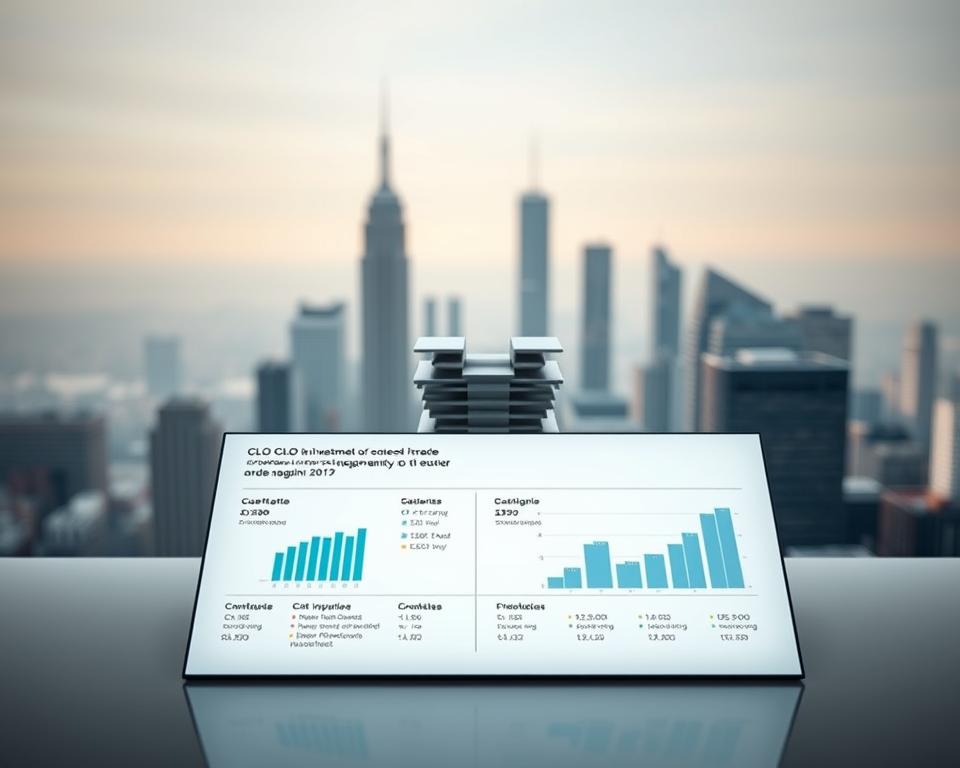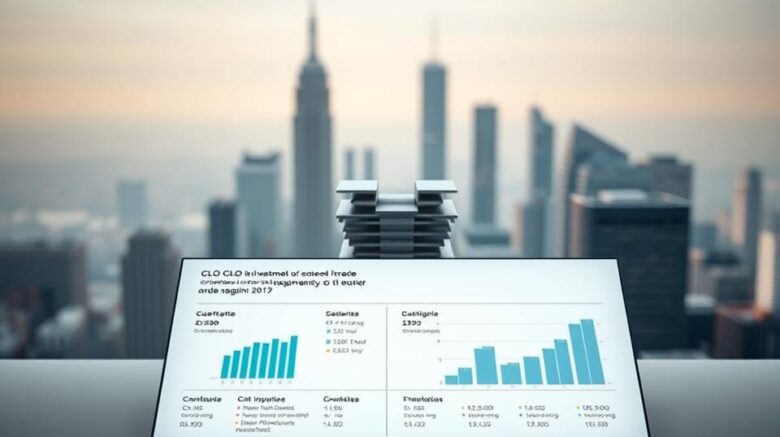Investing in CLO Equity Funds: What You Need to Know
The collateralized loan obligation (CLO) market has grown significantly over the past 35 years, evolving into a $1.1 trillion pillar of corporate financing, with US BSL CLOs accounting for about 68% of demand for US corporate loans.
CLO equity captures the difference between loan interest earned and debt owed to CLO debtholders, offering a unique investment opportunity with potential double-digit returns. This asset CLO fund class blends private equity upside with the predictable cash-flow profile of bonds.
Essential Insights

- CLO equity represents a high-risk, high-reward tranche within the $1.1 trillion CLO market.
- Quarterly distributions can deliver double-digit returns to investors.
- Grasping how CLO equity works is key to assessing its role in a diversified portfolio.
- CLO equity behaves differently from traditional fixed income or equity investments.
- Investors must weigh both the upsides and dangers prior to deployment.
CLO Equity Fundamentals
To grasp the concept of CLO equity, it’s essential to understand the underlying structure of Collateralized Loan Obligations (CLOs). A CLO functions like a corporate entity, raising capital to acquire a diversified pool of leveraged loans. Typically, it invests in between 150 and 350 leveraged loans that act as security for the CLO.
Defining Collateralized Loan Obligations
A CLO is a securitization that aggregates a broad mix of leveraged loans into an investment vehicle segmented into tranches spanning different risk and yield levels. Such a layered structure provides a menu of risk/return slices for various investor appetites.
The Role of Equity Tranches in CLO Structures
The equity tranche is a critical component of a CLO’s capital structure. It sits at the bottom, making it the first to absorb losses but also the first to benefit from excess returns generated by the underlying loan portfolio. Thus, equity investors bear the lion’s share of credit risk but can reap outsized rewards.
How CLO Equity Generates Returns
Returns on the equity tranche stem from the net interest spread after servicing debt tranches. This creates a leveraged exposure to corporate credit, making CLO equity an attractive option for investors seeking higher yields. Recognizing that both assets and liabilities reset periodically is key to forecasting CLO equity outcomes under shifting rate regimes.
CLO Equity Fund Architecture
To diversify effectively, investors must know how CLO equity funds are built. CLO equity funds are investment vehicles that allow individuals to invest in the equity tranche of Collateralized Loan Obligations (CLOs).
Waterfall Mechanics in CLOs
CLOs use a tiered waterfall to allocate cash precisely. It dictates the order of expense coverage, debt servicing, and equity distributions. Only once fees and senior debt are paid does the leftover spread flow to equity holders. The cash flow from a CLO runs through a quarterly payment waterfall, ensuring that equity investors receive distributions only after all senior obligations have been satisfied.
- The CLO funding stack places equity at the bottom of the capital structure, creating a 10:1 leverage ratio that amplifies both potential returns and risks for equity investors.
- Debt tranches gain protection via overcollateralization buffers and coverage tests.
Equity Tranche Position and Risk Profile
Because equity investors sit below all debt tranches in terms of seniority, they are the first to absorb losses if any of the underlying loans default. Yet in strong credit markets, equityholders enjoy the lion’s share of excess returns. CLO equity funds typically hold positions in multiple CLO equity tranches, providing diversification across different CLO managers, vintages, and underlying loan portfolios to mitigate concentration risk.
Understanding the structural protections and constraints within CLOs is essential for equity investors, as these features influence both the timing and magnitude of distributions throughout the investment lifecycle.
Why Invest in CLO Equity Funds?
CLO equity investments have gained popularity due to their potential for generating substantial returns through quarterly distributions. The blend of early cash flow, yield potential, and low correlation makes it an enticing portfolio diversifier.
Attractive Return Potential
Investors can aim for double-digit annual yields via quarterly cash distributions. That pattern often outpaces the return trajectories of many alts. The CLO equity asset class has historically provided strong returns, making it an attractive option for investors seeking yield.
Early Cash-Out Advantage
Unlike private equity’s J-curve, CLO equity delivers cash early on. This provides investors with earlier access to returns and reduces the weighted average life of the investment, making it a more attractive option for those seeking liquidity.
Portfolio Diversification Benefits
Investing in CLO equity also offers portfolio diversification benefits. Its historic correlations often remain below 50% versus fixed income peers like high-yield. This makes CLO equity an excellent addition to a diversified investment portfolio.
Understanding the Risks
Understanding the risks associated with CLO equity is crucial for investors looking to diversify their portfolios. CLO equity investments, while potentially lucrative, come with a unique set of challenges that require careful consideration.
Credit Risk and Default Concerns
CLO equity holders face pronounced credit risk. Loan defaults hit equity returns first, given its subordinate position. The equity tranche, being the most junior, absorbs the initial losses, making credit risk management critical.
- Defaults directly impact equity returns.
- The equity tranche is the first to absorb losses.
- Robust credit risk controls are vital to limit downside.
Volatility Considerations
Market volatility can significantly impact the mark-to-market value of CLO equity positions. The financing terms can avert fire sales, but M2M swings still pose valuation risk.
Liquidity Risks
Liquidity considerations are also important for CLO equity investors. The secondary market for these instruments can become constrained during periods of market stress, potentially limiting exit opportunities. Understanding these liquidity risks is vital for investors.
- Trading desks may thin out under stress.
- Limited exit opportunities can affect investor liquidity.
- Sound risk frameworks account for liquidity crunches.
Ultimately, the allure of high returns comes with material credit, volatility, and liquidity hazards. Prudent investors will adopt tailored mitigation tactics before committing capital.
The Power of Active Management
Active portfolio steering is crucial to unlocking CLO equity value. Ongoing surveillance and tactical adjustments by adept managers can boost equity returns markedly.
The Reinvestment Period Advantage
During the reinvestment period, typically lasting four to five years, CLO managers have the flexibility to sell existing holdings and purchase new loans, potentially upgrading the portfolio and enhancing returns for equity investors. Such proactive recalibrations are vital to amplify CLO equity upside.
Discount-to-Par Tactics
Par building involves purchasing loans at discounts to par value, which can create substantial value for equity investors due to the leveraged nature of the CLO structure. For example, a 2% discount may yield roughly 20% equity upside, underscoring tactical trading’s impact.
Refinancing and Reset Options
Managers can also refinance or reset debt to tweak the capital structure in favor of equity. Lowering borrowing costs or prolonging the reinvestment window lets equityholders capture more value when markets permit.
In sum, skilled navigation and structural tweaks are central to realizing CLO equity’s potential. Skilled managers can enhance returns through strategic trading decisions, par building strategies, and refinancing options, ultimately creating significant value for equity investors.
CLO Equity vs. Other Alternative Investments
The distinct profile of CLO equity sets it apart from traditional alternative investments. Investors weighing alts should map how CLO equity stacks up on return, duration, and liquidity.
Comparison with Private Equity
Unlike private equity’s long hold and J-curve, CLO equity delivers early, regular cash. CLO equity starts paying out within roughly half a year, shunning the typical PE J-curve. That yields a typical 3–5 year life, versus 7–10 years for PE commitments. And while it may underperform in booming markets, its stable cash profile and liquidity can be major pluses.
During reinvestment phases, annualized equity cash-on-cash returns have often hit the mid- to high-teens. That, along with a briefer time horizon, positions it well for investors wanting speedier payback.
CLO Equity vs. Fixed Income
Versus plain-vanilla credit, CLO equity can hand out much greater yields—but with amplified risk and liquidity trade-offs. Its variable-rate structure often cushions equity when rates climb, relative to fixed-rate debt. Investors must weigh these factors when determining the appropriate allocation to CLO equity within their diversified portfolio of alternative investments.
CLO Equity Performance Across Market Cycles
Investors often overlook the ongoing potential of CLO equity, assuming its heyday is over. Yet, it has shown strong resilience and counterintuitive returns in various cycles.
Downturn Performance
Equity prices may wobble in recessions. Yet, the term financing structure prevents forced selling, allowing skilled managers to capitalize on opportunities to purchase discounted loans, thereby enhancing long-term returns. Indeed, vintages launched before stress events—like pre-2007—often captured deep discounts in their reinvestment windows.
Rising vs. Falling Rate Environments
When rates climb, the variable-rate buffer often favors equity over fixed-rate debt. Its net sensitivity hinges on how much more assets reset than debt. Knowing this guides savvy investors on how to stagger vintages for smoother performance.
Its adaptability across regimes cements its role as a compelling diversifier. Performance drivers include manager prowess and the built-in leverage and credit protections of the structure.
Accessing CLO Equity Fund Investing Opportunities
Various routes exist for gaining CLO equity exposure, each with pros and cons.
Direct CLO Equity Deals
Picking individual CLO equity tranches deal by deal grants the most control. This approach allows investors to handpick CLO managers and structures that align with their investment objectives. But it demands deep credit analysis capabilities and operational bandwidth.
Captive Equity Funds
Captive equity funds provide a diversified, commingled approach to investing in CLO equity. A seasoned manager then navigates vintages and credit selection on behalf of the fund. It lowers the entry barrier and dampens single-vintage swings via built-in diversification.
Multi-Asset or Opportunistic Credit Funds
Opportunistic credit vehicles often tuck CLO equity into their broader credit mix. Although you lose some pure-play benefits, you gain multi-credit diversification under a single strategy. Review objectives and cost structures closely before committing.
Which route you pick hinges on your capital, expertise, and desired customization. Institutions tend to choose direct deals; smaller players often opt for commingled funds.
Manager Selection: Critical Factors for Success
Effective CLO equity investing hinges on selecting a skilled manager. The manager’s expertise in portfolio construction, credit selection, and active trading directly impacts equity returns.
Track Record and Experience
Past performance and tenure speak volumes about a manager’s market navigation skills. Investors typically seek managers who have demonstrated consistent performance across multiple CLO vintages.
Philosophy & Risk Controls
The investment philosophy and risk management approach of a CLO manager can significantly vary. Some chase high current payouts; others emphasize downside protection and long-term gains. Evaluating a manager’s credit research capabilities and approach to managing deteriorating credits is essential.
When selecting a manager, it’s essential to consider their risk management strategy and how it aligns with your investment goals. Strategic alignment often translates into superior risk-adjusted results.
Conclusion: Is CLO Equity Right for Your Investment Portfolio?
For seasoned investors, CLO equity’s blend of yield and diversification can be highly compelling. With its attractive, double-digit return potential and front-loaded cash flows, CLO equity can enhance risk-adjusted returns in a diversified investment portfolio.
If you can stomach the risk and time horizon, CLO equity’s low correlation makes it an excellent diversifier. Investors should consider their risk tolerance, liquidity needs, and existing portfolio allocations before investing in CLO equity.
